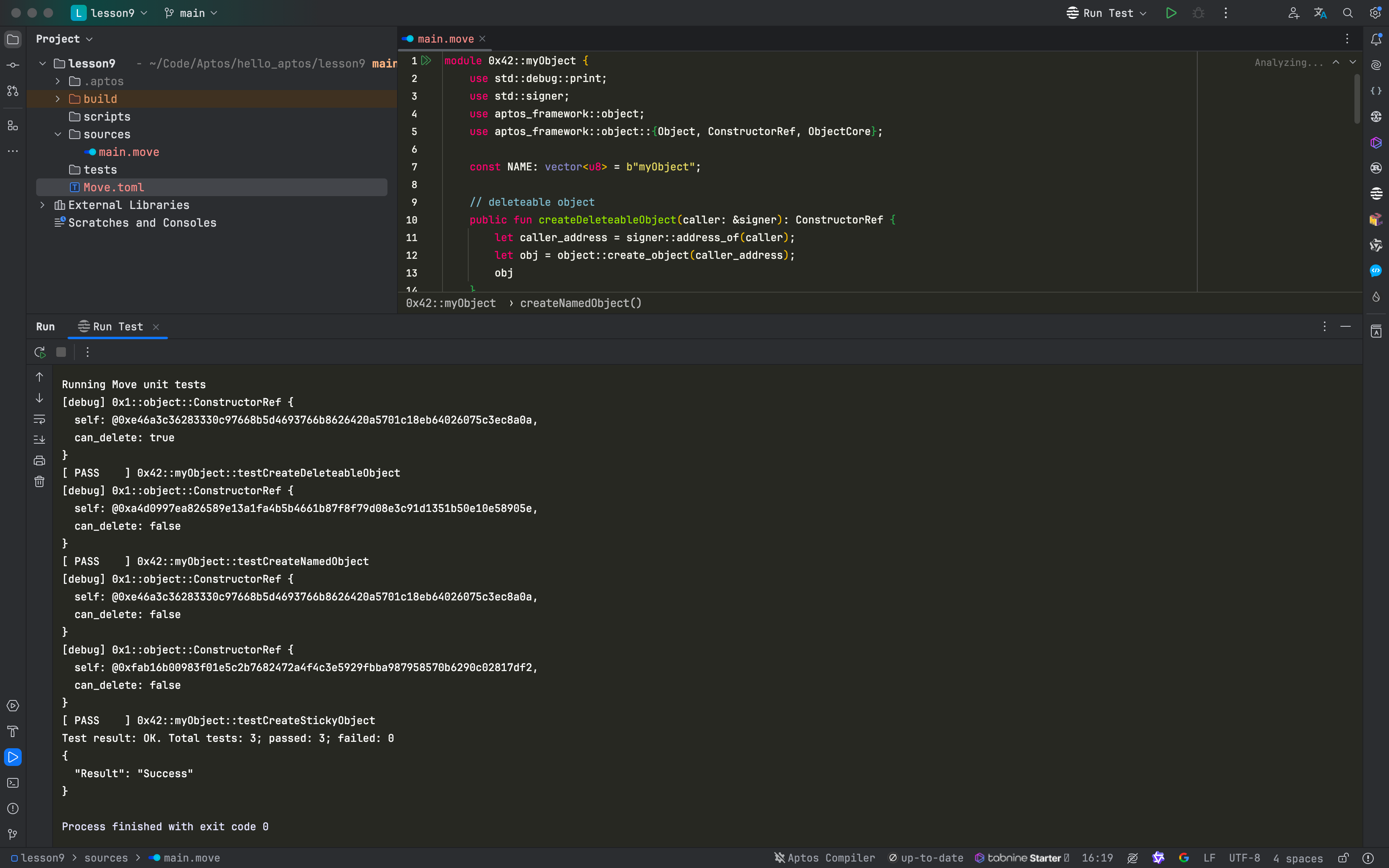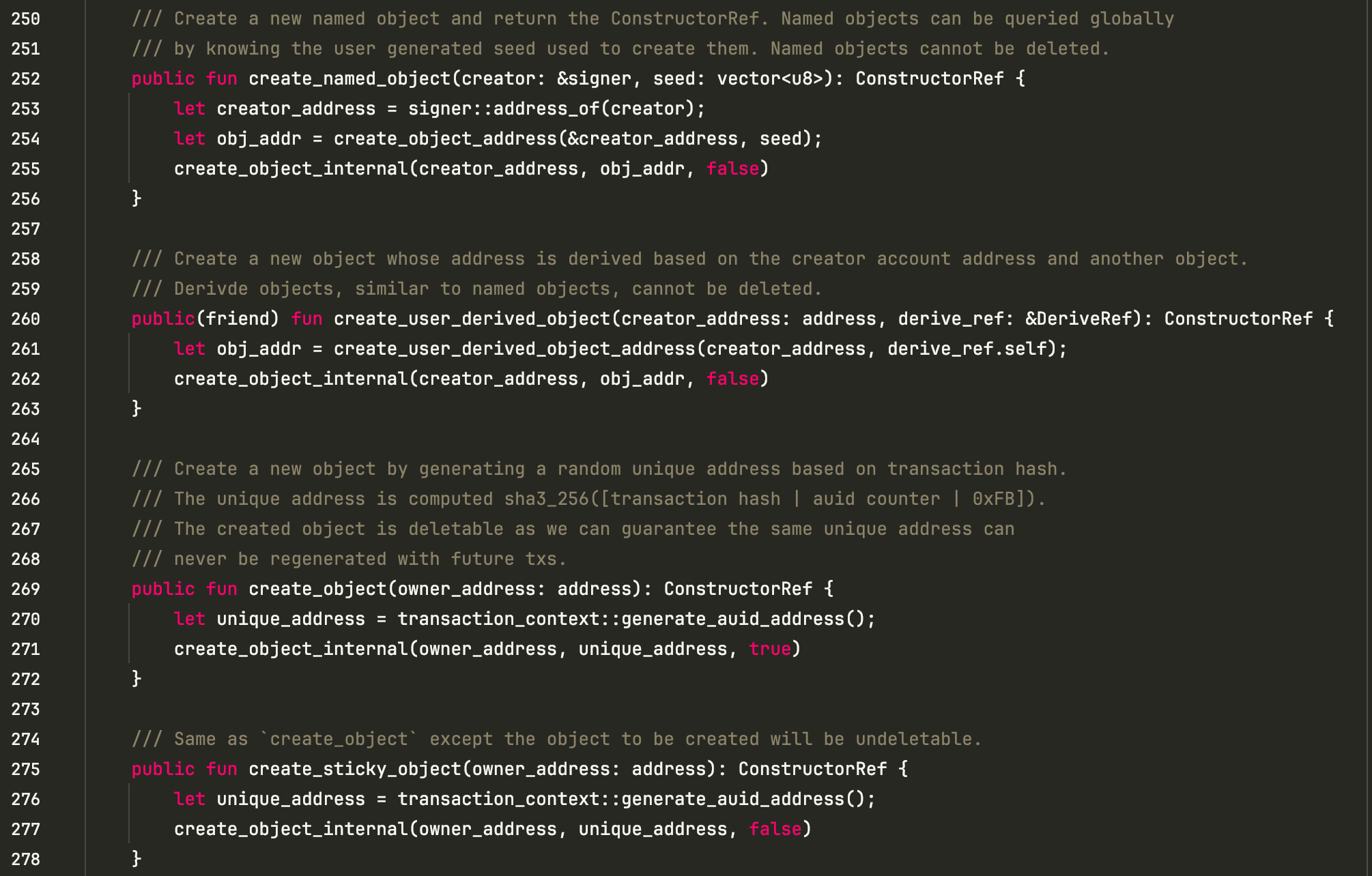Aptos
深入理解 Aptos Move 中的 Object 创建与管理
- 寻月隐君
- 发布于 2024-09-14 14:15
- 阅读 2320
深入理解AptosMove中的Object创建与管理AptosMove是一种新兴的智能合约编程语言,它基于Move的架构,专注于安全性和资源管理。在Aptos中,Object是一种关键的数据结构,提供了一种更高效的资源管理和所有权控制方式。本文将介绍AptosObjec
深入理解 Aptos Move 中的 Object 创建与管理
Aptos Move 是一种新兴的智能合约编程语言,它基于 Move 的架构,专注于安全性和资源管理。在 Aptos 中,Object 是一种关键的数据结构,提供了一种更高效的资源管理和所有权控制方式。本文将介绍 Aptos Object 的概念、类型、创建和转移方法,并通过实际代码示例,帮助开发者更好地理解其在智能合约中的应用。
本文深入探讨了 Aptos Move 中的 Object 概念,介绍了对象的两种主要类型:可删除和不可删除对象。通过实际的代码示例,展示了如何创建、设置和转移对象实例,并解释了对象的管理机制。同时,还列出了如何在 Aptos Move 环境中初始化项目并运行测试。最后,通过对核心源代码的解读,进一步说明了对象的底层实现原理,帮助开发者掌握如何在实际开发中灵活运用 Aptos Object。
认识 OBJECT
什么是 Aptos object?
Aptos Object 是一个资源容器,专门用于存储资源并管理所有权。它具有以下几个特点:
- 对象是单个地址的资源容器,用于储存资源
- 对象提供了一种集中式资源控制与所有权管理的方法
创建并转移对象实例
我们可以通过 aptos_framework 库中的 object 模块实现对象的创建与转移。以下是一个简化的示例,展示如何创建对象并将其转移到另一个地址:
module my_addr::object_playground {
use std::signer;
use aptos_framework::object::{self, ObjectCore};
entry fun create_and_transfer(caller: &signer, destination: address) {
// Create object
let caller_address = signer::address_of(caller);
let constructor_ref = object::create_object(caller_address);
// Set up the object
// Transfer to destination
let object = object::object_from_constructor_ref<ObjectCore>(&constructor_ref);
object::transfer(caller, object, destination);
}
}两类对象
- 可删除普通对象
- 不可删除对象
- 命名对象,通过固定的 signer 和特定的 seed 生成唯一地址的对象,1个地址只能生成1个
- 粘性对象,通过 signer 生成的对象,1个地址可以生成多个
代码实操
创建项目并初始化
1. 使用 aptos init 命令初始化一个新的项目。
2. 创建一个新的 Move 模块并编写对象的创建和转移逻辑。
hello_aptos on main [?] via 🅒 base
➜
mcd lesson9
hello_aptos/lesson9 via 🅒 base …
➜
hello_aptos/lesson9 on main [?] via 🅒 base
➜
aptos init
Configuring for profile default
Choose network from [devnet, testnet, mainnet, local, custom | defaults to devnet]
No network given, using devnet...
Enter your private key as a hex literal (0x...) [Current: None | No input: Generate new key (or keep one if present)]
No key given, generating key...
Account 0x4ff0520288d97315b68d0bc740a5eadf835f4ac61b2c815d8855d77d8f26f808 doesn't exist, creating it and funding it with 100000000 Octas
Account 0x4ff0520288d97315b68d0bc740a5eadf835f4ac61b2c815d8855d77d8f26f808 funded successfully
---
Aptos CLI is now set up for account 0x4ff0520288d97315b68d0bc740a5eadf835f4ac61b2c815d8855d77d8f26f808 as profile default!
See the account here: https://explorer.aptoslabs.com/account/0x4ff0520288d97315b68d0bc740a5eadf835f4ac61b2c815d8855d77d8f26f808?network=devnet
Run `aptos --help` for more information about commands
{
"Result": "Success"
}
hello_aptos/lesson9 on main [?] via 🅒 base took 5.9s
➜
aptos move init --name lesson9
{
"Result": "Success"
}
hello_aptos/lesson9 on main [?] via 🅒 base
➜
open -a RustRover .项目目录结构
tree . -L 6 -I 'build'
.
├── Move.toml
├── scripts
├── sources
│ └── main.move
└── tests
4 directories, 2 files代码示例
main.move
在 main.move 文件中,分别展示了创建可删除对象、命名对象和粘性对象的代码:
module 0x42::myObject {
use std::debug::print;
use std::signer;
use aptos_framework::object;
use aptos_framework::object::{Object, ConstructorRef, ObjectCore};
const NAME: vector<u8> = b"myObject";
// deleteable object
public fun createDeleteableObject(caller: &signer): ConstructorRef {
let caller_address = signer::address_of(caller);
let obj = object::create_object(caller_address);
obj
}
// undeleteable object
public fun createNamedObject(caller: &signer): ConstructorRef {
let obj = object::create_named_object(caller, NAME);
obj
}
// sticky object
public fun createStickyObject(caller: &signer): ConstructorRef {
let caller_address = signer::address_of(caller);
let obj = object::create_sticky_object(caller_address);
obj
}
#[test(caller = @0x42)]
fun testCreateDeleteableObject(caller: &signer) {
let obj = createDeleteableObject(caller);
print(&obj);
}
#[test(caller = @0x42)]
fun testCreateNamedObject(caller: &signer) {
let obj = createNamedObject(caller);
// let obj2 = createNamedObject(caller);
print(&obj);
// print(&obj2);
}
#[test(caller = @0x42)]
fun testCreateStickyObject(caller: &signer) {
let obj = createStickyObject(caller);
let obj2 = createStickyObject(caller);
print(&obj);
print(&obj2);
}
}
运行测试
可以通过测试函数验证对象的创建功能,如下图所示:

查看源码
通过查看 Aptos 框架中的 object.move 源码,可以更深入了解对象的底层实现逻辑。以下是 create_named_object 和 create_sticky_object 、create_object的代码片段:
/// Create a new named object and return the ConstructorRef. Named objects can be queried globally
/// by knowing the user generated seed used to create them. Named objects cannot be deleted.
public fun create_named_object(creator: &signer, seed: vector<u8>): ConstructorRef {
let creator_address = signer::address_of(creator);
let obj_addr = create_object_address(&creator_address, seed);
create_object_internal(creator_address, obj_addr, false)
}
/// Create a new object whose address is derived based on the creator account address and another object.
/// Derivde objects, similar to named objects, cannot be deleted.
public(friend) fun create_user_derived_object(creator_address: address, derive_ref: &DeriveRef): ConstructorRef {
let obj_addr = create_user_derived_object_address(creator_address, derive_ref.self);
create_object_internal(creator_address, obj_addr, false)
}
/// Create a new object by generating a random unique address based on transaction hash.
/// The unique address is computed sha3_256([transaction hash | auid counter | 0xFB]).
/// The created object is deletable as we can guarantee the same unique address can
/// never be regenerated with future txs.
public fun create_object(owner_address: address): ConstructorRef {
let unique_address = transaction_context::generate_auid_address();
create_object_internal(owner_address, unique_address, true)
}
/// Same as `create_object` except the object to be created will be undeletable.
public fun create_sticky_object(owner_address: address): ConstructorRef {
let unique_address = transaction_context::generate_auid_address();
create_object_internal(owner_address, unique_address, false)
}
本文通过详细的代码示例和概念介绍,展示了 Aptos Move 中 Object 的创建与管理方式。我们探讨了两种主要对象类型:可删除对象与不可删除对象,以及它们的实际应用场景。通过深入分析 Aptos 框架中的源码,可以更好地理解对象的生命周期和所有权转移机制,为开发者在智能合约中使用 Object 提供了更全面的参考。
